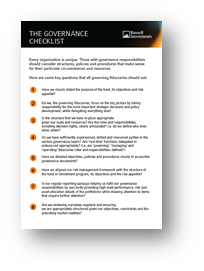Step two: The Overlooked Art of Good Governance
The five essential steps of an investment program.
Click image to enlarge

What is investment governance?
Investment governance is not investment management. Investment management is the process of implementing investment portfolios through selecting fund managers or buying and selling securities directly. In contrast, investment governance describes how investors, and their investment programs are developed and then overseen through the adoption of structures, policies, processes, and procedures.
To be most effective, governance structures and processes need to be well defined so that those involved know who is responsible for what decision and when it takes place within the investment management process.
| Roles and responsibilities | Investment and decision-making process | Items that are delegated | Reporting and review process |
|---|---|---|---|
| What the Board of Directors, Investment Committee, Outsourced CIO providers, fund managers and/or staff are responsible for. | What decisions are made and how they are made. | What stages of the investment process are delegated and to whom. | How risk, compliance, performance, and outcomes are regularly tracked and assessed. |
Common structures at investment organisations
In most organisations, it is relatively easy to identify three different types of roles:
Click image to enlarge

How decisions are made – the decision-making process
A general principle in the investment decision-making process is that decisions should be made by those most equipped to make them. For instance, the decision to buy shares in one listed company over another should be left to experienced and suitably qualified professional portfolio managers and analysts for whom buying shares is part of the daily function, rather than to a committee who meet once a quarter. Engage the services of others that do have the experience and skillsets. This might mean the hiring of an outsourced CIO for oversight of key investment policy decisions.
For effective investment decision making, governing fiduciaries should retain responsibility for issues they are best positioned to address and delegate everything else. Governing fiduciaries should, for example, decide on risk appetite which will inform the long-term strategic asset allocation, the most important determinant of long-term performance. This is because they, more than anyone else, should understand the objectives and constraints.
Assigning responsibilities: a clear understanding of where the ‘buck stops’
Identifying who does what and where the responsibility and accountability lies is a vitally important task of the governing fiduciary. Responsibility can then be assigned to the various groups in the governance structure, with the authority noted.
For instance, the governing fiduciary might be responsible for ‘deciding’ the objectives and risk appetite. The groups fulfilling the managing fiduciary role, such as an investment committee or an outsourced CIO, might ‘advise’ on those key strategic decisions while ‘deciding’ on asset class and investment strategy and fund manager selection. In addition to these roles, they would be responsible for ‘overseeing’ the operating fiduciaries who are responsible for ‘deciding’ the buying and selling of securities.
The role of the Outsourced CIO
Partnering with an Outsourced CIO does not remove the oversight and governance responsibilities from an organisation, investment committee or staff, but it can offer significant efficiencies (both cost and operational) and capability enhancements. Having a single entity with total portfolio oversight on a day-to-day basis is also an attractive element of this approach. A good Outsourced CIO can:
Click image to enlarge

Many of the functions performed by Outsourced CIOs are similar to those executed by internal CIOs. However, due to economies of scale, Outsourced CIOs can provide a broader range of services and bring scale benefits.
As highlighted good governance with robust structures, policies and procedures in place can help guide investment programs towards achieving the investment goals an organisation desires. Don’t leave the success of your investment goals to chance.
Download resources:
Governance checklist
Provides some key questions that all governing fiduciaries should be asking.
Markers of successful governance
What organisations need to ensure their governance structure provides.

